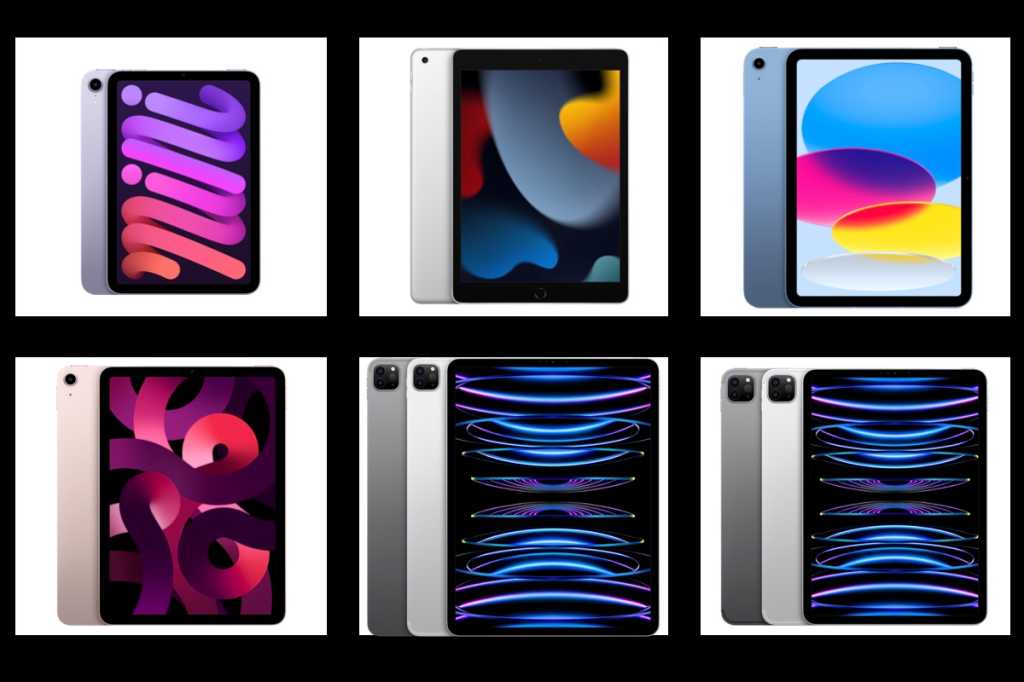Which iPad is best for you? There is a lot of choice and it can be confusing. There are four different varieties of iPad, listed below, and each is available with or without cellular (including 5G on certain models), which costs extra. That’s before we get into storage capacity, colors, and second-hand alternatives.
Our in-depth buying guide assesses the whole range of iPads sold by Apple and explores all the factors that should influence your iPad buying decision such as value for money, how much storage you need, and whether or not to buy a cellular version. We also reveal whether an updated version of each device is likely to be launched soon – answering the question of whether now is a good time to buy an iPad.
If you’re thinking of buying an iPad for college or university you might also like to read our Best iPad for students guide. You may also like to read our Best iPad for kids guide.
Every iPad Apple sells
Apple’s iPad line up is perhaps one of the most expansive product line ups presented by the company.
There’s the iPad, which represents Apple’s cheapest iPad option. The cheapest iPad is actually the 9th generation model that launched in 2021 and offers a 9.2-inch screen. This is the only iPad to offer a Home button.
A 10th generation iPad launched in October 2022 features, among other things, a larger 10.9-inch screen.
Next up is the iPad mini. This is Apple’s smallest iPad – it has a 8.3-inch display. It might be small but it is actually more powerful than the standard iPad thanks to it’s A15 processor, which is a generation newer than the A14 in the 10th gen iPad.
The iPad Air has a 10.9-inch display, like the 2022 iPad, but it’s smaller, thinner and lighter than that device. It’s also got an M1 processor, making it a more powerful option than the iPad mini.
The iPad Pro comes in two sizes and a variety of capacities all the way up to a massive 2TB. While both models have an M2 processor, the 11-inch iPad Pro is a very different proposition to the 12.9-inch iPad Pro, the latter has a superior Liquid Retina XDR display, which can support 1000 nits max full screen, 1600 nits peak brightness. Both screens offer ProMotion technology, which means that the refresh rate can be really high so that users experience smooth scrolling and better gaming performance.
The table below summarises the main features of the iPads Apple sells, and highlights the price for each.
| Model (launch date) | Key features + specs | Storage + cellular options | Price + buy link |
| iPad 10.9-inch ’10th gen’ (October 2022) |
• Medium 10.9-inch screen |
64GB 64GB (4G) |
|
| iPad 10.2-inch ‘9th gen’ (September 2021) |
• Medium 10.2-inch screen |
64GB 64GB (4G) |
|
| iPad mini ‘6th gen’ (September 2021) |
• Small 8.3-inch screen |
64GB 64GB (4G) |
|
| iPad Air ‘5th gen’ (March 2022) |
• Medium 10.9-inch screen |
64GB 64GB (5G) |
|
| iPad Pro 11-inch ‘4th gen’ (October 2022) |
• Medium 11-inch screen |
128GB 128GB (5G) |
$799 / £899 $999 / £1,079 |
| iPad Pro 12.9-inch ‘6th gen’ (October 2022) |
• Huge 12.9-inch screen |
128GB 128GB (5G) |
$1,099 / £1,249 $1,299 / £1,429 |
What to look for when buying an iPad
As you can see from the above there are a lot of iPads sold by Apple – and that table doesn’t even include the many previous-generation iPads that are still on sale at various resellers and at Apple’s Refurbished Store.
When confronted by so much choice what should you consider when deciding which iPad to buy?
For many the choice will be based on price and value for money. Some may be influenced by the screen size, others by the weight. The ability to get more than 256GB storage may be important, as may the inclusion of Face ID – or Touch ID. Finally the decision of whether to get a cellular version, which invites the assessment of minefield of network contracts, will no doubt be a factor for some.
We will look at each of those factors below.
Which iPad is the best value for money?
One person’s value for money is another person’s extravagance.
You might be looking for the cheapest iPad. That would be the 9th generation iPad, launched in September 2021, but, despite the introduction of the 10th generation iPad, still being sold by Apple. This is the cheapest iPad Apple sells right not, but it isn’t the cheapest it has been sold for. If you are based outside of the U.S. the 2021 iPad has has a price hike. But even if you are based in the U.S. where the price stayed at $329, that’s not the price you have to pay – we’ve seen it discounted to $299 during Amazon’s Prime Day, for example.
If you are happy to buy an older iPad model then there are plenty of discounts available while they are still in stock. There are also some great savings to be had on refurbished models. We recommend you check the following deals roundups, where you can see the best prices right now on various iPads:
Other buyers simply want the best iPad they can get for their money, but that all depends on budget. Back in the day we would have suggested that if you wanted a powerful iPad you should steer clear of the cheapest model in the range. But that’s not true any more: even the 10.2-inch iPad that launched in September 2021 offers a reasonably impressive package. The device’s low price, combined with some great tech, makes this budget iPad an attractive option.
But that iPad has effectively been superseded, despite the fact that it is still on sale. The 10th generation iPad introduced in October 2022 has a bigger 10.9-inch screen, a 12MP rear-facing camera (rather than 8MP), an A14 rather than A13 processor, and 5G. Plenty of reasons to justify spending a little more to get the newer model. How much more you will need to pay depends on where you live. In the U.S. the 10th gen iPad costs from $449, $120 more than the 9th gen model. For U.K. readers the 2022 iPad costs $499, which is £130 more than the 9th gen model. That $120/£130 may we worth spending if you want a bigger screen, better camera and newer processor.
If you have more to spend, what can you get for your money? The iPad mini more than justifies its slightly higher price tag of $499/£569 with it’s faster A15 processor, True Tone flash, and a fully laminated, better quality, display, among other things. But its biggest draw will probably be its size – for those who want a small iPad. The iPad mini is not much bigger than a hard backed book making it the perfect size to carry around in a bag and a great size for kids.
Apple
Next up is the iPad Air, which starts at $599/£669, so another £150/£170 on top of the 10th generation iPad or $100/£100 more than the mini. It might be worth every extra penny if you want an M1 processor in your iPad – which means you will have access to features that the less powerful iPads lack. You might be thinking that now the iPad has a 10.9-inch display there is less of a difference between the iPad and iPad Air, but the iPad Air display is still superior, fully laminated and with an antireflective coating (like the iPad mini).
The iPad Pro, updated in October 2022, is the ultimate in this category. Starting at $799, the Pro has a lot to offer, with advanced cameras and an M1 chip for starters. But we think these features are probably more than the average person needs.
Those are the prices that Apple sells its iPads for, but you don’t have to pay that much. Take a look at our regularly updated iPad deals page for the lowest prices and best discounts on iPads new and old.
iPad screen size: Which size iPad to choose
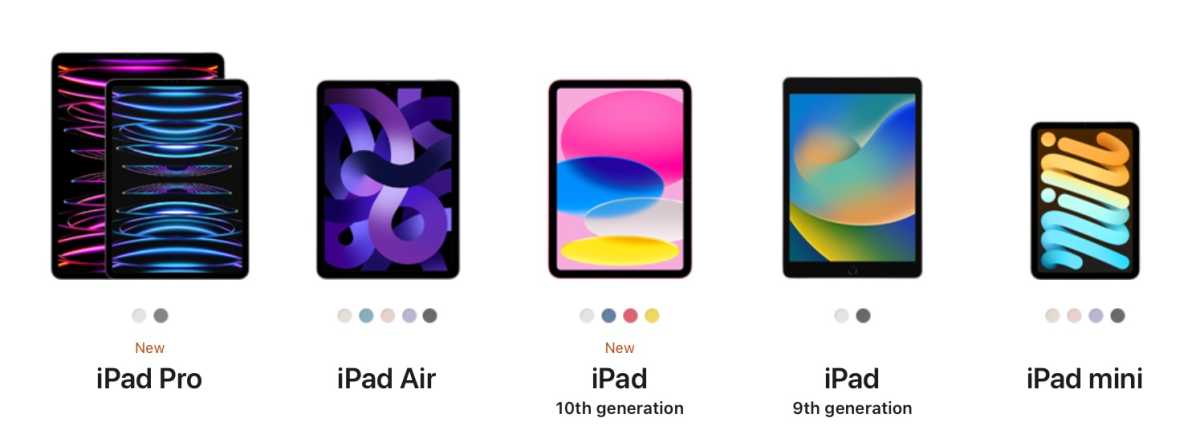
Apple
Size is a question of taste rather than simply going for the biggest iPad you can get your hands on. Bigger isn’t necessarily better if what you need is small and light.
The most obvious aspect of this decision comes down to screen size. You’ve got five options:
- 8.3-inch iPad mini
- 10.2-inch iPad (9th gen)
- 10.9-inch iPad Air and iPad (10th gen)
- 11-inch iPad Pro
- 12.9-inch iPad Pro
All screens are measured diagonally from corner to corner, or from the place where the corners would be.
A larger screen size doesn’t necessarily mean that the iPad itself is a lot larger, in the case of the 9th generation iPad the 10.2-inch display fits in a 250.6 x 174.1 x 7.5mm unit, but the iPad 10th generation dimensions are 248.6 x 179.5 x 7mm, despite the 10.9-inch screen.
But how big a screen do you really need?
You can get an idea of the comparative sizes in the picture above. But you can also think of the tablets in terms of print publications: the mini is roughly the height and width of a paperback book; the mid-size iPads are closer to a hardback (albeit much slimmer); and the 12.9-inch iPad Pro is like a magazine.
The larger screen is obviously better for immersive entertainment. Whether watching films or playing games, it’s a more enjoyable, richer experience. But really this is a question of priorities. Are you more set on getting maximum screen space, or are you willing to compromise on that front in order to get a lower price tag and improved portability?
- iPad Pro 12.9-inch (2022): 280.6 x 214.9 x 6.4mm; 682g/684g (Wi-Fi/cellular)
- iPad Pro 11-inch (2022): 247.6 x 178.5 x 5.9mm; 466g/468g
- iPad Air 10.9-inch (2022): 247.6 x 178.5 x 6.1mm; 461g/462g
- iPad 10.9-inch (2022): 248.6 x 179.5 x 7mm; 477g/481g
- iPad 10.2-inch (2021): 250.6 x 174.1 x 7.5mm; 487g/498g
- iPad mini 8.3-inch (2021): 195.4mm x 134.8mm x 6.3mm; 300.5g/308.2g
Also read: Every iPad display compared.
Want the lightest iPad? As you’d expect, the iPad mini is a lot lighter than the other iPads, and even more so since the September 2021 update. There’s a big gap between that device and even the mid-size iPads. As well as its markedly lower weight the mini also has a smaller body, which slips easily into a rucksack or jacket pocket. If you plan to mainly use your iPad out and about, on holiday or commuting, or perhaps you’re buying an iPad for a child, the mini is your best bet.
The iPad, iPad Air and 11-inch Pro are pleasingly portable, but they still can’t match the mini for portability. The iPad has a similar length and width to the Air, but is thicker and heavier; the Pros are slimmer still.
The 12.9-inch Pro is considerably less portable than its smaller cousins, but we think Apple has done well to keep it down to 682g: it remains a slender, relatively lightweight and portable alternative to a laptop.
How much storage do you need?
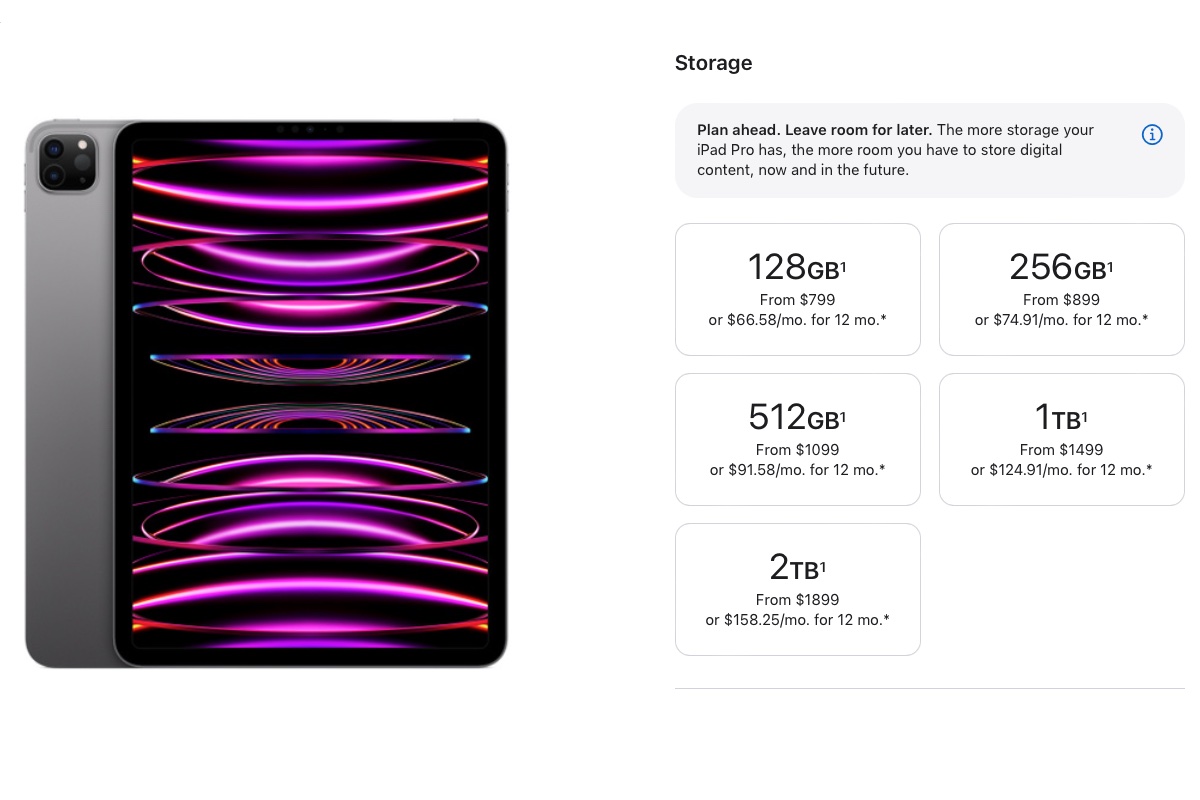
Apple
The five iPads offer anywhere from 64GB to 2TB of storage, but if you are looking at an old, refurbished or preowned iPad you could be confronted with as little as 32GB storage – right now we will tell you that 32GB is not enough!
But what storage capacity do you really need for an iPad?
Well, first of all remember that you can’t upgrade the storage of an iPad at a later date: this is your limit from now until you buy another iPad, so aim high and buy as much storage as you can afford. It’s better to spend an extra few pounds now than to buy an entire new iPad in six months’ time.
Storage capacity is mainly used up by three things: music, photos, and videos, in increasing order of storage drain. If you want to keep lots of films or TV shows–or even a few, to be honest–then you need high storage: probably 128GB or higher for video fans. (If you’re buying an iPad with the kids in mind, remember that you’ll want storage space for multiple episodes of their favorite show on a long car journey.)
The same applies to large photo or music libraries, to a lesser extent, although iCloud Photos and iTunes Match make it possible to keep your stuff in the cloud and access it remotely (if you pay the fees for iCloud storage).
The other thing that will fill up your storage is apps, especially games which will use up a lot of space. For that reason gamers should aim high on storage: 128GB is a good bar to aim at.
See: How much storage do you need on an iPhone or iPad? for more advice.
Should you get the most powerful iPad?
The iPad Pro models are, as you would expect, faster than their smaller and cheaper equivalents, next up is the Air, then the iPad mini and finally the iPad. You can get an idea of relative speed by looking at a few relevant specs:
- iPad Pro 12.9-inch (2022): M2; 8GB/16GB RAM
- iPad Pro 11-inch (2022): M2; 8GB/16GB RAM
- iPad Air (2022): M1; 8GB RAM
- iPad mini (2021): A15 Bionic; 4GB RAM
- iPad 10.9-inch (2022): A14 Bionic; 4GB RAM (tbc)
- iPad 10.2-inch (2021): A13 Bionic; 3GB RAM
The M2 and M1 chip has won widespread acclaim in the Mac range and produces outstanding performance in the iPads. But that doesn’t mean the A chips are sub-standard, or incapable of running modern apps; keep in mind that much of the software on the App Store was designed with A chips in mind, and even now most developers will want to make their software accessible for as many iPad owners as possible.
There is a good reason to choose the M-series chips over the A-series though. Some of the best iPadOS 16 features will only work with the M2 or M1 iPads. These include features like Stage Manager, which is a new feature for organizing your windows. There are also rumors that one day Apple may make a cutback version of macOS available on the iPad – but this will be probably be restricted to the M2 chip, if indeed it ever happens..
But speculation aside, how powerful you need your iPad to be will be based on your your requirements (and how long you intend to use your iPad for). The most demanding graphic-design, video-editing and audio apps will see better performance on the M2 and even M1 processor, so if you’re looking at high-level workloads multiple years down the line the M2 and M1 would be a better option.
But for most users the A15 will be comfortably fast enough for the mid- and quite long term, and even the A14 (from 2020) and A13 Bionic (which arrived in 2019) perform perfectly well on today’s apps.
Another important factor to consider is memory. The iPad 10.2-inch has 3GB of RAM; the mini and iPad 10.9-inch have 4GB. The Air gets a jump up to 8GB, while the 2022 Pros have either 8GB or a whopping 16GB of RAM, depending on your storage tier: the 1TB and 2TB versions get the higher RAM allocation.
Overall, we would advise those who want to use highly demanding apps, such as video and image editors and graphically advanced games, to choose an iPad Pro or Air. If you’re going to be using your tablet for the odd bit of email and web surfing, you’ll find an iPad or iPad mini perfectly decent.
With these general observations out of the way, it’s time to look at each device in more depth. For each iPad we record the essential information, its pros and cons, which buyer should pick it and whether now is a good time to buy.
Should you get a Cellular iPad?
For most people cellular connectivity is a luxury, even if it’s a nice one to have. For an extra $100 or so, you’ll be able to access the web and email, and use connected apps, away from a Wi-Fi network. You need to factor in the cost of a data plan and find a network provider.
Consider carefully how often you’re going to do that: with an iPad mini there’s likely to be more on-the-go use than with a full-size iPad, but it’s still a lot to pay for something you may only use from time to time. Have you got a regular (overground) commute where you’d enjoy catching up on news headlines or email? Then it could be worth the extra.
We think the best option, if you want to be able to get data on your iPad when you are out and about, is to create a hotspot and share it from your iPhone. Then you can use your iPad as if it was on the cellular network. Read about how to create an iPhone hotspot to share your mobile web connection to your iPad.
Just bear in mind that the cellular option also brings with it a GPS radio, meaning you’ll be able to input accurate location data when using your device on the go.
The other concern when buying a cellular iPad is whether to buy your iPad on a contract. Network providers will allow you to pay for your iPad and the data contract over a number of months – but after that term is up, and certainly not before, you may not be able to switch to a different data provider. Buying on contract may also mean that the iPad is locked to the original contract provider – which can also be a problem if you want to sell it in the future. Here’s how to unlock an iPad from its network, once you’ve fulfilled your contractual obligations.
Should you buy a refurbished iPad?
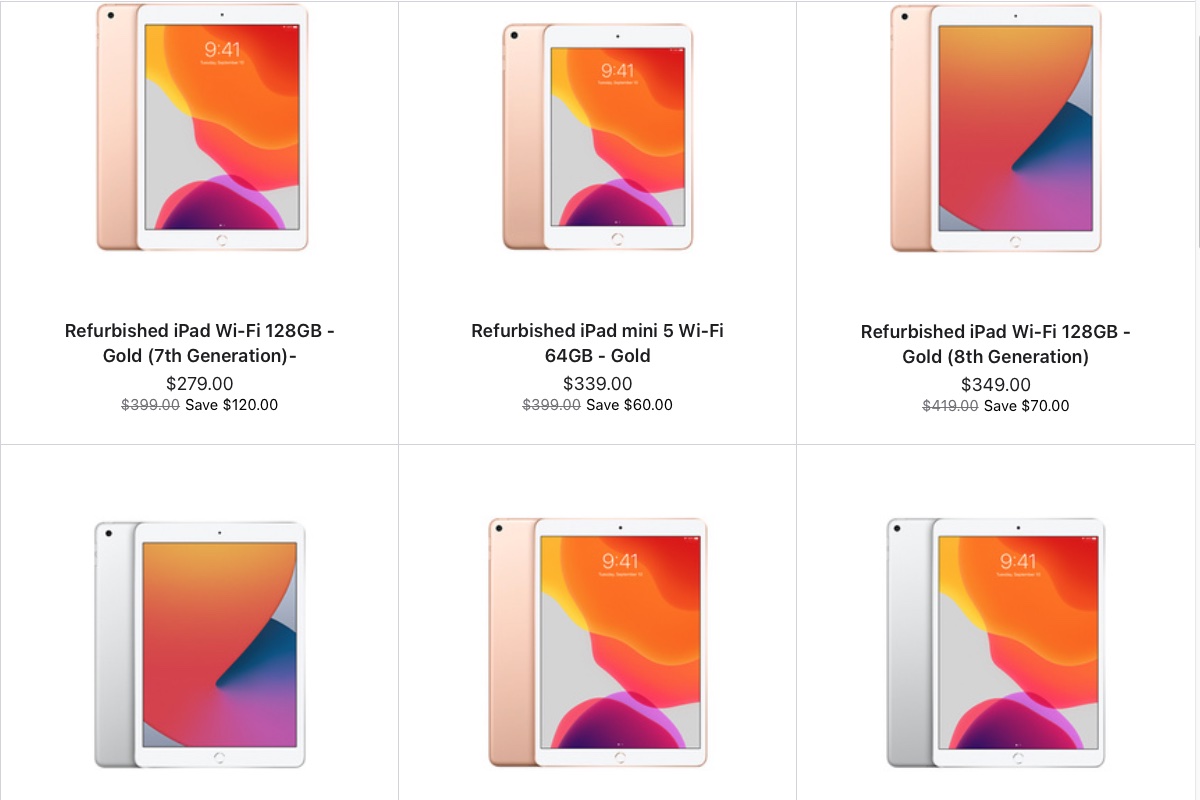
Apple
We’ll mention this only briefly because it’s covered in detail here: Why a refurbished iPad could be the best tablet for you, but one option you should absolutely consider is Apple’s Refurbished Store. It’s a sort of halfway house between new and second-hand: the devices are generally ones that have been returned within the 28-day period in which you are legally allowed to change your mind about a purchase, or they have been returned due to a fault that has been rectified, or they were ex-display or ex-demo units from Apple’s stores or marketing. You can rest assured that Apple has checked all the refurbished iPads that it sells thoroughly, replaced any problematic components, and rated them as good as new (and you get a full one-year warranty to prove it).
Apple’s not the only place to buy a refurbished iPad, so beware that all refurbished iPads are not the same, so do check the small print before you buy. Look for refurbished models that have been fully checked out by Apple certified engineers, especially those that come with a guarantee.
Our best advice is to only consider the current or previous generation iPads when looking at refurbished models, then you are less likely to be caught out by a sub-par tablet.
Buying a refurbished iPad from a reputable company is definitely preferable to buying a used iPad from someone on eBay. It’s too often the case that secondhand iPads sold that way end up as useless bricks because the person selling it didn’t properly log out of their account.
Another way to save money is to buy from a reseller who is selling discontinued stock at a discount. We often see resellers significantly dropping the price on older iPad models that are usually just one generation out of date – just beware, they sell out quick!
Should you buy the newest iPad generation?
Speaking of older iPads, even if functioning perfectly right now, older models will reach the end of their useful life sooner than the newest models and that is a good reason to avoid buying an iPad that is more than one or two generations old. But keep in mind that iPads tend to start slowing down at around two to three years of age; at the four- or five-year mark you should expect noticeable loss of performance and you won’t be able to get all the latest software updates.
The ‘current’ iPad range was mostly updated in 2022: including the iPad Pro models in October 2022, the iPad 10th-generation in October 2022, and the iPad Air in March 2022. The iPad 9th-generation and iPad mini came out in September 2021.
Another reason to buy a recent iPad is the operating system it runs. Apple only supports the most recent three versions of iPadOS with security updates, so that means that only iPadOS 14, 15 and 16 are supported – iPadOS was introduced in September 2020.
The following iPads can run the latest iPadOS 16 version:
- iPad Pro (all models – from 2015)
- iPad Air (3rd generation and later – from 2019)
- iPad (5th generation and later – from 2017)
- iPad mini (5th generation and later – from 2019)
So, while you don’t have to buy the newest generation, we would recommend that you buy one that was launched relatively recently to be sure that Apple will support it for as long as you intend to own it. On that basis, any of the iPads listed above should be a safe bet because they support the iPadOS that Apple will support for the next three years.
Best iPad: How the iPads compare
If the above advice hasn’t made it clear, the iPad that is best for you will depend on what you need from an iPad. If you just want an iPad for reading books, watching movies and TV shows, email and web browsing, then you don’t need all the bells and whistles. An iPad or iPad mini might be best here.
If you are looking for an iPad that will do everything that a laptop can, then you might want to consider a model that is more powerful and supports additional components, including a one of Apple’s newer keyboards or the Apple Pencil 2. In which case the iPad Air might suit you.
And if you want will be using your iPad for gaming, or video editing, or photo editing, or anything high powered and graphic intensive, then you will probably be looking at an iPad Pro.
Below we will run through every iPad you can buy so you can find the one that’s best for your needs.
iPad 10.2-inch (9th-generation, 2021) – best for button lovers
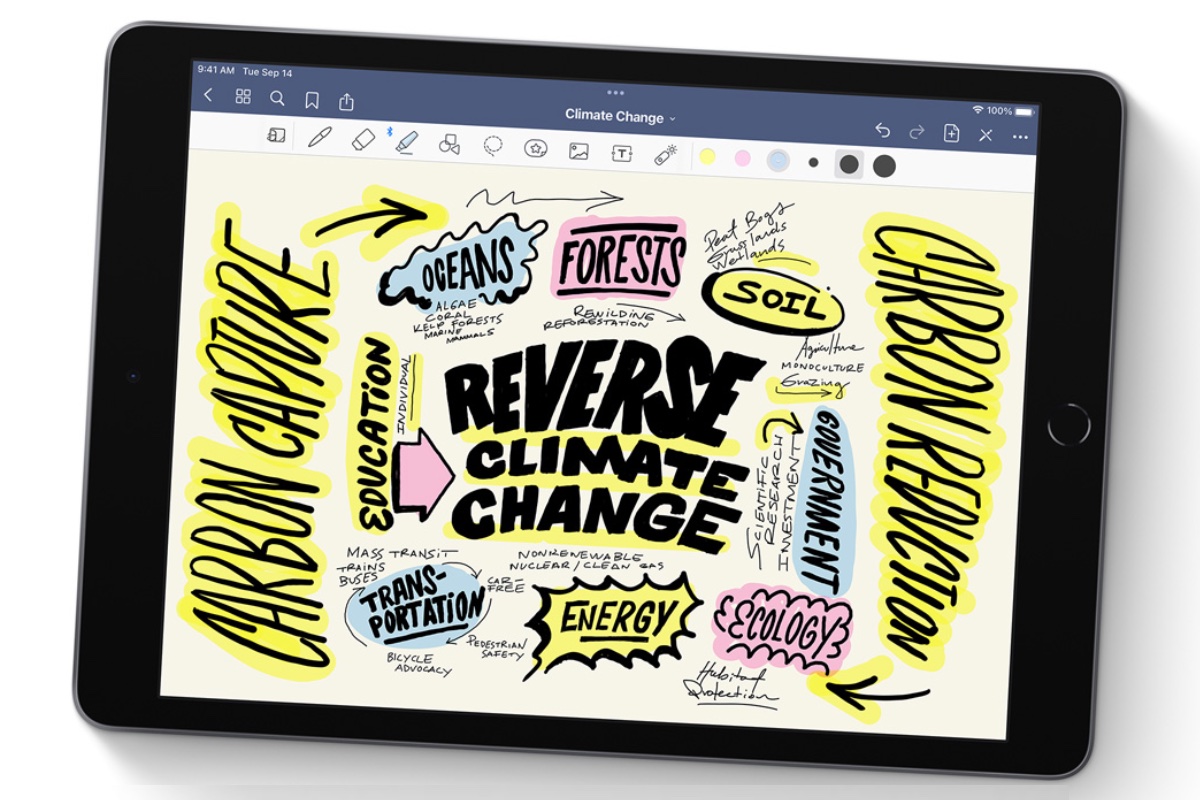
Apple
This is the cheapest iPad you can buy (although the price has actually gone up everywhere other than in the U.S.), while remaining powerful enough for most purposes. The iPad 10.2-inch has a good screen size for gaming and watching movies, while remaining slim, light and portable. But the biggest reason to buy this iPad is the Home button – this is the only iPad with a Home button, which will be a key selling point for some users.
Pros: Thin and light, although not as thin and light as the Air. Low price. Its A13 chip will handle what’s on the App Store right now, although the arrival of the M1 chip in the Air and the M2 in the Pro models could end up pushing the top tier of apps out of this iPad’s reach.
Cons: Feels cheap due to the unlaminated screen. Can only use the first-gen Apple Pencil.
Best for: Anyone who needs a big screen (not a huge screen; they’ll want the 12.9-inch iPad Pro) but is on a budget, and can cope without the latest in processing and camera power. It’s a good option for kids, students and anyone who wants a Home button and has a lot of Lightning cables that they don’t want to go to waste (this is the only iPad not to have switched to a USB-C port).
Is now a good time to buy? It’s an okay time to buy, but you might want to consider the newer version that came out in October 2022.
Read more: iPad 10.2-inch (2020) review
View iPad 10.2-inch on the Apple Store
Best deals for the 2021 iPad:

$299

$329

$329.99

$344.94
iPad 10.9-inch (10th-generation, 2022) – best value for money
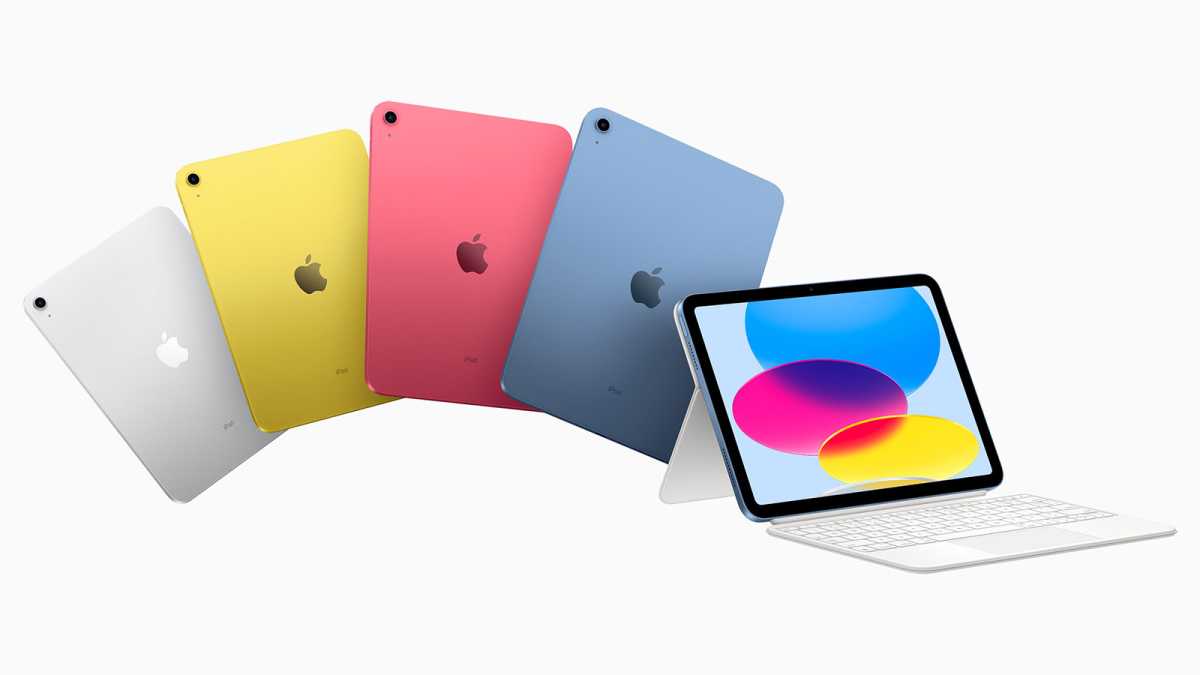
Apple
64GB: $449/£499
256GB: $599/£679
64GB (cellular): $599/£679
256GB (cellular): $769/£859
The 2022 iPad (10th generation) isn’t the cheapest iPad – that’s the previous generation iPad that is still on sale – but the new look iPad does offer a lot of features than it’s older sibling lacks. While it costs about $120/£130 more, it does feel like it’s worth the extra money – or at least it is worth the extra money if you like the fun colors (the old model only came in Space Gray and silver), want a larger 10.9-inch screen (up from 10.2-inch), and prefer a USB-C connector to Lightning. It’s also capable of 5G (if you were looking at the cellular model you wouldn’t want the 4G-capable 9th gen).
Pros: Thiner and lighter than the predecessor, but not as thin and light as the Air. Same size display as the Air. A14 chip will be powerful enough for a good few years. No more Home Button – but there is still Touch ID (on the Power button).
Cons: Still feels cheap due to the unlaminated screen (will Apple ever update this?). Can only use the first-gen Apple Pencil.
Best for: Anyone who needs a big screen (not a huge screen; they’ll want the 12.9-inch iPad Pro) but is on a budget, and can cope without the latest in processing. It’s a good option for anyone who likes the look of the iPad Air, but not the price.
Is now a good time to buy? It’s a good time to buy as it went on sale in October 2022.
Read more: iPad 10.9-inch 2022
View iPad 10.9-inch on the Apple Store
Best deals for the 2022 iPad:
The iPad 10th generation has only just gone on sale, but as more resellers start to stock it you will see competitive prices below.

$413.00

$449

$449

$449.00
iPad mini (2021) – Best for those on the go and kids

This generation of iPad mini launched in September 2021. The iPad mini is available in two storage capacities (64GB, which will be plenty for most people, or 256GB), and four colors: silver, gold, Space Gray and a new purple version.
The biggest draw of the iPad mini is probably its diminutive stature. This is the smallest and lightest iPad and as such is perfect for carrying around in a bag or handing to children when they need entertaining. Whichever version you go for, you’ll get an A15 Bionic processor chip, a Liquid Retina screen and 12MP/12MP rear/front cameras.
Pros: Very portable and respectably powerful. Affordable, and cheapest version has good amount of storage (64GB). Supports second-gen Apple Pencil.
Cons: Small screen, which may not be great for those who get eyestrain or who like immersive films and games. Outside the U.S. prices have gone up significantly since the initial launch.
Best for: The portability-conscious. Gamers on the go. Tablet photographers. Ebook enthusiasts. Kids.
Is now a good time to buy? Reasonably. Apple updated the iPad mini in September 2021 and it was quite a significant one, including a redesign. It won’t be updated again until 2023. Keep up with the latest speculation with our iPad mini 7 guide.
Read more: iPad mini (2021) review
Best deals for the iPad mini:

$469.00

$499.99

$549.95

$649
iPad Air (2022) – Best for power in an affordable package
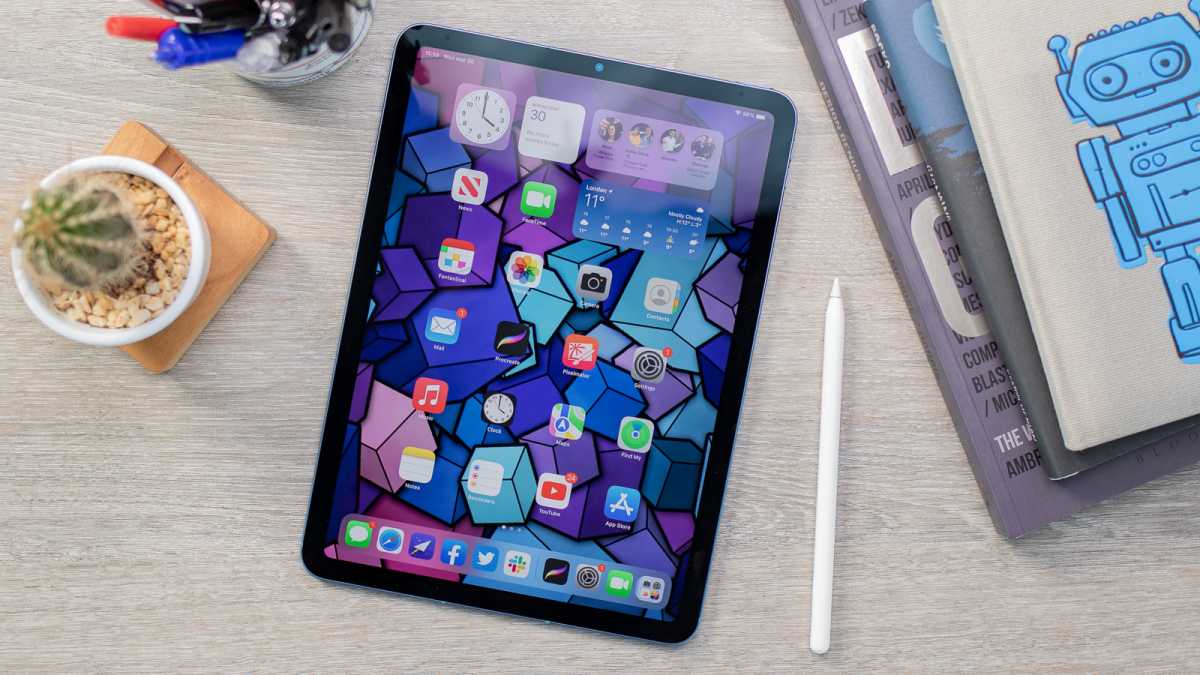
Foundry
Having fallen behind the rest of the pack while being neglected throughout 2021, the Air roared back to relevance in March 2022. At that time the Air presented an appealing alternative to the more expensive Pro models, matching them in key areas of design, tech spec and feature set (although by the end of 2022 the Pro models had sped ahead with a more powerful components).
The 2022 Air is powered by an M1 processor, powerful and energy-efficient processors you may remember from their widely praised performance in the Mac. The M1 pushes the iPad Air far ahead of the iPad mini and standard iPads with their A-series chips. Like all recent iPads it features an all-screen design, with no Home button. As with the 10th-gen iPad and the iPad mini, biometric security is handled by a fingerprint sensor in the power button rather than Face ID, which is reserved for the Pros. It has superb cameras (the front-facing 12MP camera and Center Stage), supports a wide range of Pro accessories, and now features 5G.
Pros: Beautiful design. Superb processing and graphics power. Cheaper than the iPad Pro.
Cons: Screen doesn’t feature ProMotion. Since the early 2022 launch prices have dramatically increased outside the U.S.
Ideal for: Tablet gamers and anyone who wants to be able to run the most demanding apps now and in the future. Pro users (business, creative, design) who can’t afford an iPad Pro.
Is now a good time to buy? Absolutely. It came out in March 2022 and won’t be updated until 2023.
Read more: iPad Air (2022) review
View iPad Air (2022) on the Apple Store
Best deals for the iPad Air:

$589

$596.94

$599

$599.99
iPad Pro 11-inch (2022) – Best for power in a small package

- 128GB: $799/£899 / 128GB (cellular): $999/£1,079
- 256GB: $899/£1,019 / 256GB (cellular): $1,099/£1,199
- 512GB: $1,099/£1,249 / 512GB (cellular): $1,299/£1,429
- 1TB: $1,499/£1,699 / 1TB (cellular): $1,699/£1,879
- 2TB: $1,899/£2,149 / 2TB (cellular): $2,099/£2,329
The current generation of iPad Pro models went on sale in October 2022. While this update brought no external changes, a number of important upgrades were hidden within.
The 2022 Pros feature M2 chips, as found in the 2022 MacBook Pro and MacBook Air. As a result the iPad Pro has shot ahead of the iPad Air with its M1 chip. Combined with a 8-16GB RAM the iPad Pro is incredibly powerful – some might say more powerful than it has any right to be.
The front-facing camera is 12MP and on the back you will find two cameras, a 12MP Wide and 10MP Ultra Wide for flexible photography and video options.
The iPad Pro models benefit from ProMotion screens, but one of the key differences between the 11-inch and 12.9-inch iPad Pro is the screen quality – if you want the best screen you need to look at the 12.9-inch model (more on that next). Another benefit of the iPad Pro is that it goes up to a maximum storage allocation of 2TB.
Pros: Slim and light; dual cameras; Face ID; devastatingly quick and power-efficient processor.
Cons: Very expensive. Its power could be overkill for many. Price increases outside the U.S.
Ideal for: Creative types who don’t need the absolutely largest screen. It’s great for watching films and TV shows (and offers quad-speaker audio to match), but there are other screens in the range that are a similar size and a lot more affordable.
Is now a good time to buy? The current Pros only came out in October 2022, which means we’re now in the danger zone where a new model could appear any day. There’s a good chance it will happen in the fall of 2022: keep up with the latest launch news with our new iPad Pro 2022 guide.
Read more: iPad Pro 11-inch (2022)
View 11-inch iPad Pro on Apple Store
Best deals for the 11-inch iPad Pro:

$769.99

$799

$799.00

$904.95
iPad Pro 12.9-inch (2021) – The ultimate iPad power package for creative pros
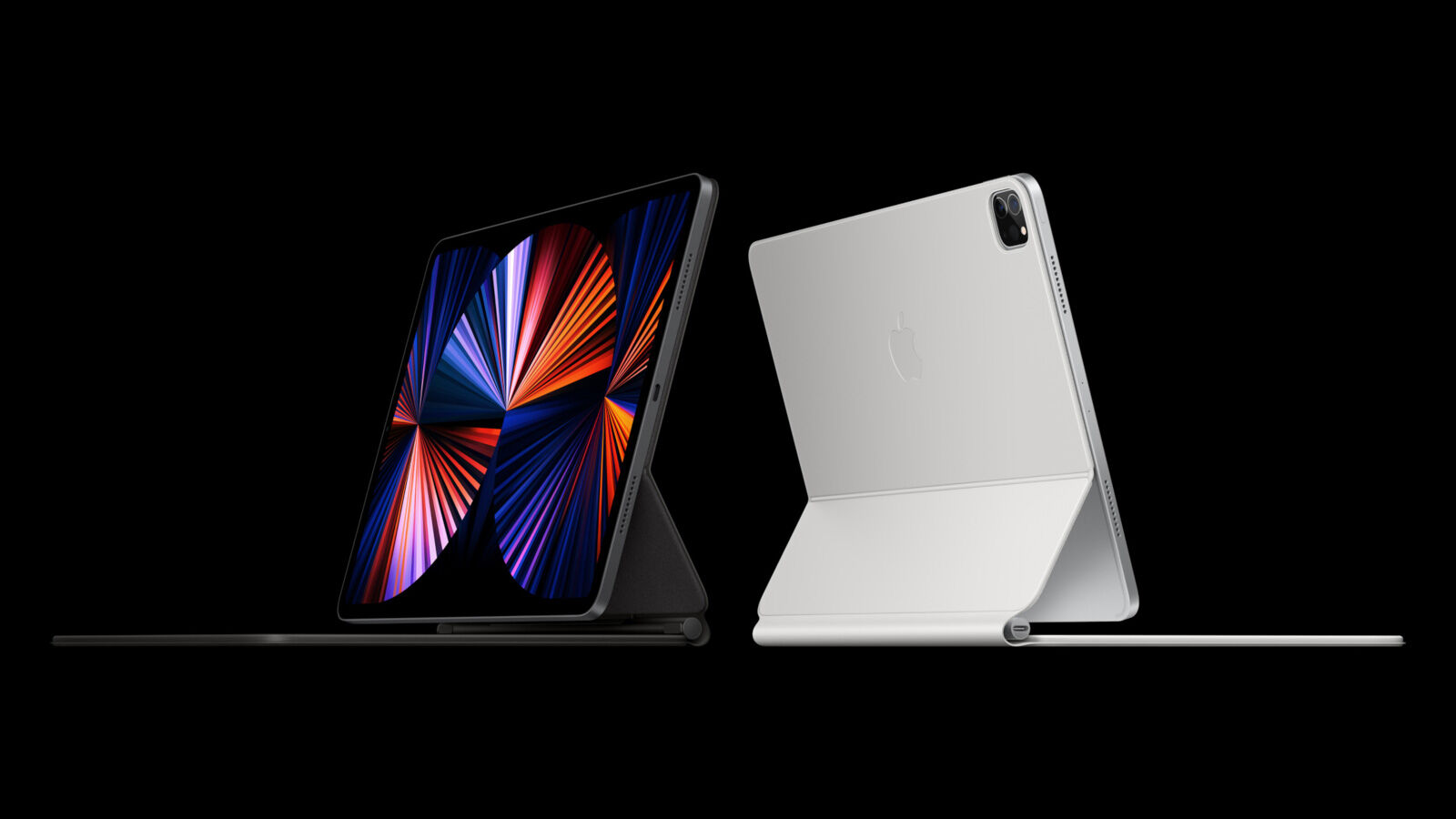
- 128GB: $1,099/£1,249 / 128GB (cellular): $1,299/£1,429
- 256GB: $1,199/£1,369 / 256GB (cellular): $1,399/£1,549
- 512GB: $1,399/£1,599 / 512GB (cellular): $1,599/£1,779
- 1TB: $1,799/£2,049 / 1TB (cellular): $1,999/£2,229
- 2TB: $2,199/£2,499 / 2TB (cellular): $2,399/£2,679
The iPad Pro 12.9-inch, was updated in October 2022, offers the biggest screen ever on an Apple tablet, squeezed into a relatively small and very thin chassis. In other respects it’s largely the same as the 11-inch Pro: super-fast processor (the M2) with lots of RAM, excellent cameras, and a user experience that looks more than capable of replacing a laptop.
The main exception is the XDR display, which means it can get really bright – 1,000 nits max full screen, 1,600 nits peak (HDR content only). This feature is only available on the 12.9-inch model. The 11in iPad Pro tops out at 600 nits max brightness. The XDR display is backlit by a huge array of mini-LEDs, offering subtle localized dimming across the screen, plus a million-to-one contrast ratio.
This is all thoroughly impressive. But on the down side, the 12.9-inch Pro is far less portable than the mid-size iPads (it remains admirably slim, but the sheer screen area makes it a handful) and ruinously expensive, particularly at those upper storage tiers.
Pros: Huge screen (12.9-inch); extremely fast processor with bags of RAM; excellent dual cameras; four speakers; Face ID, XDR display.
Cons: Least portable iPad currently available (although it is very slim); very expensive; processor speed will be overkill for many prospective buyers; hugely inflated prices outside of the U.S.
Ideal for: Creative types most of all, but anyone who needs a big screen will be interested. Gamers and those who enjoy consuming media on the go will like the combination of a sumptuous screen and a quad-speaker audio system.
Is now a good time to buy? The device launched in October 2022 so it will be a while before a new version appears.
Read more: 12.9-inch iPad Pro (2022)
View 12.9-inch iPad Pro on Apple Store
Best deals for the 12.9-inch iPad Pro:

$1,094.00

$1099.00

$1099.00

$1099
Buying advice: Which iPad should you buy?
The iPad 10.2-inch (2020) is a good option for newcomers and those whose usage will be light, but it’s now been superseded by the iPad 10.9-inch, which offers better features for a higher price, if you can afford to spend more it would be worth it.
For most people, however, our recommendation would still be the iPad Air (2022). The update in March 2022 brought it an M1 processor, which is more than enough for an iPad right now. Mind you, it’s still expensive compared to the standard iPad and the iPad mini, and to most rival tablets out there.
The iPad mini is mainly recommended for those who see portability as their main priority. It’s an excellent little device, although the smaller screen makes it less immersive for games and entertainment options.
The remaining iPads will be too expensive for the average buyer. The 11-inch and 12.9-inch Pro models are amazingly powerful and well made, and the arrival of the M2 is excellent news – but probably more power than anyone really needs right now.
Finally, before taking the plunge, have you considered if a laptop might suit your needs better? See iPad vs MacBook for more advice on that front.

